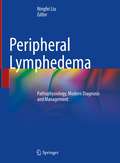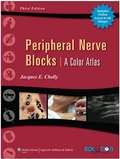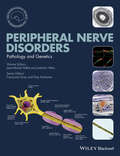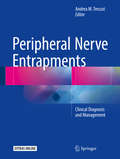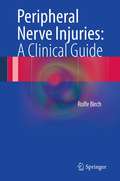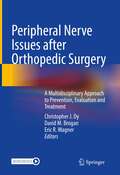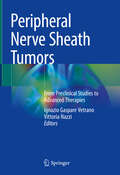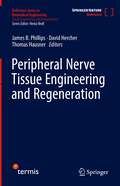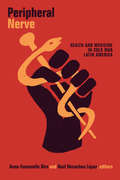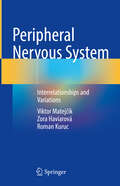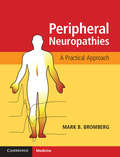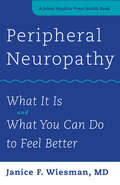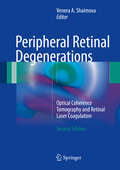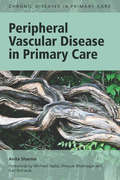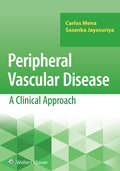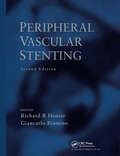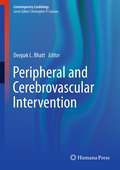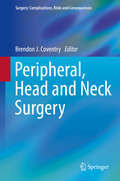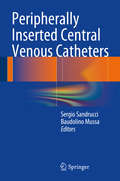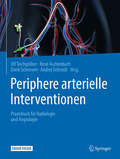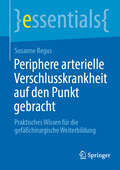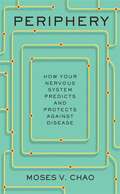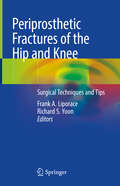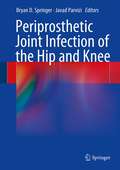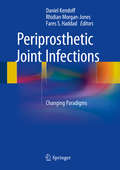- Table View
- List View
Peripheral Lymphedema: Pathophysiology, Modern Diagnosis and Management
by Ningfei LiuThis book provides extensive knowledge of peripheral lymphedema, including the etiology and pathophysiology of the disease, as well as the anatomy and physiology of the lymphatic system and guide for the treatment of lymphedema to clinicians. The ultimate goal of lymphedema therapy is the targeted and individualized treatment. New technology of multimodality lymphatic imaging emerged in the recent years largely improves the diagnosis of lymphatic circulation disorders. The treatment of peripheral lymphedema is expected to have new achievement. This book illustrates the latest achievements in clinical and basic research of lymphedema to the clinical investigators as well as basic researchers. Pathogenesis of lymphatic system, diagnosis of lymphedema, treatment and further complication management are demonstrated in this book. Some special lymphedema related syndromes, issues on prevention and prognosis are also included.
Peripheral Nerve Blocks: A Color Atlas (3rd Edition)
by Jacques E. ChellyThoroughly updated for its Third Edition, this best-selling full-color atlas is a step-by-step guide to performing more than 60 peripheral nerve blocks, including those used in children. For each nerve block, the book provides detailed information about indications, patient positioning, needle size, drug selection, volume for infusion rate, anatomic landmarks, approach, and technique and offers tips for maximizing effectiveness and minimizing complications. Full-color clinical photographs and line art demonstrate anatomic landmarks, patient positioning, and techniques. This edition offers new material on ultrasound guidance and continuous catheter techniques.
Peripheral Nerve Disorders: Pathology and Genetics
by Joachim Weis Jean-Michel VallatPeripheral Nerve Disorders: Pathology and Genetics is a definitive, clinically-oriented guide to the pathology of peripheral nerve disorders. <P><P> These commonly seen neurological challenges have many causes and accurate diagnosis is often necessary via pathological analysis. New techniques exploiting molecular biological knowledge have opened up new vistas to understanding the pathogenesis of these disorders, and hence their effective management. This new title takes a disease-oriented approach to understanding the pathology of these conditions. It combines classical and contemporary techniques to enable practitioners in neurology and neuropathology to better understanding of the disease processes underlying patients' presentations and to formulate appropriate management plans. Peripheral Nerve Disorders: Pathology and Genetics is a valuable resource for neurologists, neuropathologists, pathologists, neurobiologists and geneticists.
Peripheral Nerve Entrapments
by Andrea M Trescot Abipp FippFeatured as a single volume, this is a comprehensive guide to possible nerve entrapment syndromes and their management. Each chapter covers a single nerve, or group of closely related nerves, and goes over the clinical presentation, anatomy, physical exam, differential diagnosis, contributing factors, injection techniques, neurolytic/surgical techniques, treatments of perpetuating factors, and complications. Nerve entrapments can occur throughout the body and cause headaches, chest pain, abdominal pain, pelvic pain, low back pain, and upper and lower extremity pain. As an example, one of the most common forms of nerve entrapment syndrome, Carpal Tunnel Syndrome, affects roughly 1 in 20 people in the United States, and is only one of several types of entrapment syndromes possible for the median nerve. Chapters are also extensively illustrated and include 3D anatomical images. The additional online material enhances the book with more than 50 videos - at least 2 for each nerve. This enables readers to easily navigate the book. In addition to a conventional index it includes a "Pain Problems Index" for searching by symptom. Peripheral Nerve Entrapments: Clinical Diagnosis and Management is a long-needed resource for pain physicians, emergency room physicians, and neurologists.
Peripheral Nerve Injuries: A Clinical Guide
by Rolfe BirchPeripheral Nerve Injuries: A Clinical Guide is a fully illustrated and informative reference on injuries within the peripheral nervous system. It incorporates new knowledge in molecular and cellular events which underlie the response of nerves to injury, regeneration and neuropathic pain. Written by a leading expert in the field, Peripheral Nerve Injuries: A Clinical Guide, is a valuable resource for surgeons in residence and training.
Peripheral Nerve Issues after Orthopedic Surgery: A Multidisciplinary Approach to Prevention, Evaluation and Treatment
by Christopher J. Dy David M. Brogan Eric R. WagnerPeripheral nerve issues are potential sequalae of orthopedic surgery, even after cases in which technically excellent surgery was performed. These injuries can impede the expected recovery of function after the primary surgery. Given the manifold challenges associated with recovery of peripheral nerve injuries, this book is designed as a multidisciplinary guide to the diagnosis, prognostication and treatment of peripheral nerve issues after common orthopedic surgeries. Beginning with an overview of nerve compression, injury and regeneration, as well as a presentation of the current diagnostic and imaging modalities for peripheral nerve injuries, this unique text is organized by anatomic region and by type of procedure performed. Topics covered include shoulder and elbow arthroplasty and arthroscopy, fractures of the hand and wrist, hip preservation surgery, total knee replacement, open surgery of the foot and ankle, lumbosacral myeloradiculopathy, and more. Each chapter is authored by both a subspecialty surgeon who routinely performs the surgeries described and a subspecialized hand/peripheral nerve surgeon with experience in evaluating and treating nerve issues after that particular injury. Emphasis is placed on multidisciplinary team approaches, patient counseling, and technical aspects of surgical treatment. Generously illustrated and written by experts in the field, Peripheral Nerve Issues after Orthopedic Surgery is a truly interdisciplinary resource for orthopedic, plastic, hand and trauma surgeons, physiatrists, trainees, and all professionals evaluating and managing postoperative peripheral nerve issues.
Peripheral Nerve Sheath Tumors: From Preclinical Studies to Advanced Therapies
by Ignazio Gaspare Vetrano Vittoria NazziThis book offers an update about peripheral nerve sheath tumors (PNST), both in their benign and malignant forms (MPNST). Starting from the most innovative preclinical studies about genetic and omics characterization, it then explores the traditional and advanced imaging modalities (ultrasound, DTI, etc) and the electrophysiological assessment. Another relevant part is reserved to the description of the most recent surgical techniques (fluorescent dye for intraoperative surgical guidance, neurophysiological monitoring, esoscopic view). Finally, new oral treatment for PNST related to neurocutaneous diseases (as selumetinib in plexiform neurofibromas) is described. Written by worldwide experts in each specifical field, if offers a multidisciplinary vision to PNST, approaching the topic in a translational way, from preclinical studies to the current medical practice. The ideal readers are all health operators involved in the treatment of these tumors- from neurosurgeons to radiologists, neurologists, geneticists, biologists, etc) as well as medical students in these disciplines.
Peripheral Nerve Tissue Engineering and Regeneration (Reference Series in Biomedical Engineering)
by James B. Phillips David Hercher Thomas HausnerThis updatable book provides an accessible informative overview of the current state of the art in nerve repair research.The introduction includes history of nerve repair research and establishes key concepts and terminology and will be followed by sections that represent the main areas of interest in the field: (1) Biomaterials, (2) Therapeutic Cells, (3) Drug, Gene and Extracellular Vesicle Therapies, (4) Research Models and (5) Clinical Translation. Each section will contain 3 - 6 chapters, capturing the full breadth of relevant technology. Bringing together diverse disciplines under one overarching theme echoes the multidisciplinary approach that underpins modern tissue engineering and regenerative medicine. Each chapter will be written in an accessible manner that will facilitate interest and understanding, providing a comprehensive single reference source. The updatable nature of the work will ensure that it can evolve to accommodate future changes and new technologies. The main readership for this work will be researchers and clinicians based in academic, industrial and healthcare settings all over the world.
Peripheral Nerve: Health and Medicine in Cold War Latin America (American Encounters/Global Interactions)
by Raúl Necochea López Anne-Emanuelle BirnBuenos Aires psychoanalysts resisting imperialism. Brazilian parasitologists embracing communism as an antidote to rural misery. Nicaraguan revolutionaries welcoming Cuban health cooperation. Chilean public health reformers gauging domestic approaches against their Soviet and Western counterparts. As explored in Peripheral Nerve, these and accompanying accounts problematize existing understandings of how the Cold War unfolded in Latin America generally and in the health and medical realms more specifically. Bringing together scholars from across the Americas, this volume chronicles the experiences of Latin American physicians, nurses, medical scientists, and reformers who interacted with dominant U.S. and European players and sought alternative channels of health and medical solidarity with the Soviet Union and via South-South cooperation. Throughout, Peripheral Nerve highlights how Latin American health professionals accepted, rejected, and adapted foreign involvement; manipulated the rivalry between the United States and the USSR; and forged local variants that they projected internationally. In so doing, this collection reveals the multivalent nature of Latin American health politics, offering a significant contribution to Cold War history.Contributors. Cheasty Anderson, Anne-Emanuelle Birn, Katherine E. Bliss, Gilberto Hochman, Jennifer L. Lambe, Nicole Pacino, Carlos Henrique Assunção Paiva, Jadwiga E. Pieper Mooney, Raúl Necochea López, Marco A. Ramos, Gabriela Soto Laveaga
Peripheral Nervous System: Interrelationships and Variations
by Viktor Matejčík Zora Haviarová Roman KurucThis book comprehensively evaluates the morphological and clinical aspects of the peripheral nervous system and its involvement in various pathologies. It thoroughly describes its topography, morphology, its peculiarities - that are missing in anatomical and surgical textbooks- and their possible influence on the clinical picture. Their preoperative diagnosis is difficult, even impossible. Figures and line drawings enrich the view of structures that so far. have only been partially documented. The authors' descriptions are based on clinical observations and systematic work on the 246 human bodies of healthy people who died a sudden or violent death (most often in car accidents). Dissection is the most precise method to elucidate the range of variability, which is often largely responsible for the failure of surgical treatments. Their recognition can minimize damage to nerve structures, and the acquired knowledge can help clarify clinical signs and symptoms in surgery or internal medicine. The data presented in this publication will however be useful for traumatologists, orthopedists, spinal surgeons, neurosurgeons, plastic surgeons, as well as neurologists and neurophysiologists, and to all those who are dealing with or are interested in this field.
Peripheral Neuropathies: A Practical Approach
by Mark BrombergDo you find the evaluation of a patient presenting clinical symptoms of distal extremity numbness and weakness daunting and complex? Are you unsure of the diagnostic processes and best-practices in the treatment of peripheral neuropathy? This invaluable guide presents a practical approach to the diagnosis and successful management of patients with peripheral neuropathies. <P><P>Starting with a structured series of patient queries for symptoms and examination signs, the diagnostic process emphasizes the role of electrodiagnostic tests in defining the neuropathy. Specific neuropathies are presented with their epidemiology, causative pathology, diagnostic and laboratory factors, alongside advised treatments and overall management strategies. This leading resource will assist non-neuromuscular neurologists, physiatrists, neurology and physiatry residents, and will also be useful to electromyographers, proving an ideal aid for busy clinic schedules.<P> Presents a full clinical characterization of symptoms and signs of a neuropathy.<P> Shows correlations between electrodiagnostic findings and underlying pathology.<P> Classifies neuropathies by type.
Peripheral Neuropathy: What It Is and What You Can Do to Feel Better (A Johns Hopkins Press Health Book)
by Janice F. WiesmanHealing and symptom relief from an expert in treating this debilitating and dangerous condition.Nearly one in fifteen people—that's 20 million people in the United States—suffers from peripheral neuropathy, or nerve damage. Caused by such conditions as diabetes, cancer, vitamin deficiencies, and kidney disease as well as certain drugs and toxins, neuropathy brings numbness, tingling, and burning in the feet, legs, and fingertips. Neuropathy can be more than uncomfortable—it can be disabling: people whose fingertips are numb may find it hard to button clothing and complete other everyday tasks. Neuropathy is often dangerous, as well: people who cannot feel their feet are more likely to stumble and fall, and they may not notice injuries that need medical attention. Dr. Janice F. Wiesman, a neurologist with twenty years of experience helping people who have neuropathy find relief, shares her special insights into this painful and debilitating condition. With exceptional clarity, Dr. Wiesman begins by outlining the basics of nerve anatomy and function. She explains how peripheral neuropathy is diagnosed and treated, describes neuropathy’s disparate causes, and offers readers lifestyle changes that can help keep nerves healthy. A useful glossary defines terms, patient stories offer real-world experiences, and illustrations provide a visual key to the condition. A detailed resources section points the reader to reliable web sites and organizations that offer more help.Concentrating on the most common types of neuropathy, Dr. Wiesman provides hope, help, and comfort to patients, families, and caregivers.
Peripheral Retinal Degenerations
by Venera A. ShaimovaThis book provides an illustrated guide to peripheral retinal degenerations and the role of spectral domain coherence tomography (SD-OCT) in diagnosis and treatment. The book discusses 73 clinical cases and gives detailed information on the principles of SD-OCT and its application in the imaging of peripheral retina. Peripheral Retinal Degenerations: Optical Coherence Tomography and Retinal Laser Coagulation, 2nd edition, discusses a broad range of retinal pathologies such as chorioretinal degenerations, posterior vitreous detachment, vitreoretinal adhesions and tractions and includes a plethora of high-quality clinical images throughout. Ophthalmologists and retinal specialists will find this updated edition to be the perfect didactic resource for furthering skills and knowledge in this clinical area.
Peripheral Vascular Disease in Primary Care (Radcliffe Ser.)
by Anita Sharma'Peripheral vascular disease is common and has a significant adverse effect on the quality of life. A general practice with a list size of 6000 patients will have approximately 30 symptomatic patients with peripheral vascular disease' - Anita Sharma Peripheral vascular disease is a commonly neglected condition and therefore often presents in an advanced stage or in a life-threatening manner. General practitioners can play a vital role by making early diagnoses, prompt referrals, and in coordinating vascular risk factor management in primary care. This book is a concise and practical guide to recognising, managing and reducing the cardiovascular risk factors in patients with peripheral vascular disease (PVD). Completely up-to-date, it offers clear direction for all primary care professionals. 'A pleasure for any busy professional to read and an excellent source and reference book for all primary care professionals. Students, nurses and registrars will be surprised with the descriptions of various pathologies simply explained, which they will seldom have noticed while working on hospital wards.' Dr Michael Taylor, in his Foreword 'A welcome source of knowledge and information, particularly for those working in the primary care setting with the aim of improving their standards of care.' - Dr Deepak Bhatnagar, in his Foreword 'Anita Sharma is an experienced, practising GP whose book on PVD offers new insights for primary care professionals and is a generous contribution to the work of primary care practitioners everywhere.' - Gail Richards, in her Foreword
Peripheral Vascular Disease: A Clinical Approach
by Carlos Mena Sasanka JayasuriyaPart of the new Clinical Approach series—which focuses on key topics in cardiology—this pragmatic, comprehensive guide is intended for residents, practitioners, advanced practice nurses, and physician assistants, and covers arterial, venous, and lymphatic diseases. Easy-to-read chapters are written by clinical experts in interventional cardiology, interventional radiology, vascular surgery, and podiatry, and begin with helpful quick-reference summaries.
Peripheral Vascular Stenting, Second Edition
by Richard R Heuser MD FACC FACP Biamino GiancarloPeripheral vascular disease is a common, disabling malady, and patients seeking treatment may turn to their cardiologist for advice and treatment. Conventional treatment has always been medical management and, inevitably, surgical bypass, even amputation. Stents have had a significantly high impact on endoluminal treatment outcomes by preventing injury to the lumen, reducing the potential for hyperplasia and restenosis, as well as the likelihood of plaque disruption and embolization. This second edition brings together a combination of all the current evidence-based information with personal experience and is presented by a team of distinguished operators.Short Contents
Peripheral and Cerebrovascular Intervention
by Deepak L. BhattPeripheral and Cerebrovascular Intervention draws upon experts from diverse fields to provide readers with a comprehensive foundation for understanding and performing endovascular procedures--from the basic steps to the most current and advanced techniques. Individual chapters focus on primary intervention sites, including lower extremity, renal/mesenteric, subclavian/upper extremity, carotid/vertebral, intracranial, and venous interventions. Additionally, chapters covering critical limb ischemia and abdominal and thoracic aortic aneurysms are included. By incorporating valuable clinical information, such as indications, contraindications, complications, and discussions of surgical techniques and procedures, this book is a valuable resource for the busy practitioner and will be of interest to all interventional and general cardiologists, radiologists, and neurologists; vascular surgeons; internists; and residents and fellows.
Peripheral, Head and Neck Surgery
by Brendon J. CoventryPeripheral, Head and Neck Surgery is part of the series: Surgery -Complications, Risks and Consequences edited by Brendon Coventry.
Peripherally Inserted Central Venous Catheters
by Sergio Sandrucci Baudolino MussaIndications for central venous cannulation in critically ill patients have increased dramatically, but central venous access has the drawbacks of morbidity and a scarcity of experienced operators. Ultrasound-guided peripheral venous access offers a solution, in that it reduces morbidity and can be performed by a dedicated nursing team. The aim of this book is to teach the fundamentals of this emerging technique. Advice is provided on choice of materials; maneuvers for positioning of peripherally inserted central venous catheters (PICCs), techniques for evaluation of PICC tip placement; prevention, diagnosis, and management of complications; and organization of a dedicated team within a hospital or a supportive care program. Legal and economic issues are also considered. The book will be of interest to a wide range of professionals, including nutritionists, oncologists, anesthesiologists, surgeons, registered nurses, nurse practitioners, physicians, physician assistants, and radiologists.
Periphere arterielle Interventionen: Praxisbuch für Radiologie und Angiologie
by Ulf Teichgräber René Aschenbach Dierk Scheinert Andrej SchmidtDieses Praxisbuch fasst den aktuellen „State of the Art“ der peripheren arteriellen Interventionen in kompakter und übersichtlicher Weise für den Leser zusammen. Das interdisziplinäre Autorenteam aus Radiologen, Angiologen und Gefäßchirurgen hat dabei Wert auf schnellen und geballten Wissenstransfer der doch teilweise sehr komplexen Themengebiete gelegt. Dabei werden alle Facetten der interventionellen Therapie der pAVk der unteren Extremität beleuchtet.Sowohl Einsteiger als auch Fortgeschrittene finden alle relevanten Informationen -angefangen von der klinischen Untersuchung, Diagnostik sowie Vor- und Nachbehandlung der Patienten bis zu peripheren Interventionen- strukturiert dargestellt. Neben den Einführungskapiteln zeigen spezielle Kapitel alle gängigen und spezialisierten Verfahren zur Rekanalisierung von peripheren arteriellen Gefäßen der unteren Extremität auf.Inhaltliche Schwerpunkte: Aufklärung und Vorbereitung Materialkunde Diagnostische Methoden (CT, MRT, Ultraschall, Angiographie) Strahlenschutzaspekte Antikoagulation Ballonangioplastie „Drug-eluting“-Technologie Stenting Lysetherapie Thrombektomie Artherektomie Kritische Ischämie Dieses Buch ist für den Arbeitsplatz gedacht und als Praxisbuch konzipiert. Viele praktische Tipps der Autoren sollen Ihnen im Alltag helfen, schnell und effizient das individuelle Therapiekonzept für Ihre Patienten zu finden.
Periphere arterielle Verschlusskrankheit auf den Punkt gebracht: Praktisches Wissen für die gefäßchirurgische Weiterbildung (essentials)
by Susanne RegusAnhand zahlreicher Beispiele und Situationen aus dem Klinikalltag wird das Krankheitsbild der peripheren arteriellen Verschlusskrankheit Schritt für Schritt erläutert. Der Fokus liegt auf den für die klinische Tätigkeit wichtigen Aspekten von Diagnostik und Therapie. Ein typisches Fallbeispiel durchzieht die Darstellung als roter Faden. Weitere Bände zu anderen gefäßchirurgischen Erkrankungen sind geplant.
Periphery: How Your Nervous System Predicts and Protects against Disease
by Moses V. ChaoA leading neuroscientist argues that the peripheral nervous system, long understood to play a key role in regulating basic bodily functions, also signals the onset of illness.The central nervous system, consisting of the brain and the spinal cord, has long been considered the command center of the body. Yet outside the central nervous system, an elaborate network of nerve cells and fibers extends throughout our bodies, transmitting messages between the brain and other organs. The peripheral nervous system, as it’s known, regulates such vital functions as heart rate, digestion, and perspiration and enables us to experience the barrage of sounds, tastes, smells, and other sensory information that surrounds us. But beyond these crucial roles, the peripheral nervous system might do even more: it might warn us of diseases in our future.As Moses Chao argues in Periphery, from Parkinson’s disease to autism to dementia, many neurological conditions emerge not in the brain but rather within the peripheral nervous system, in the dense network of nerves that wrap around the gastrointestinal tract. What’s more, dysfunctions of the peripheral nervous system can signal the onset of disease decades before symptoms like tremor or memory loss occur. Fortunately, unlike nerves in the brain and spinal cord, peripheral nerves can heal and regenerate in response to injury and aging. The therapeutic implications are remarkable. Chao shows how, with a better understanding of the peripheral nervous system, we could not only predict and treat neurological diseases long before their onset, but possibly prevent them altogether.Full of new ideas and bold interpretations of the latest data, Periphery opens exciting avenues for medical research while deepening our understanding of a crucial yet underappreciated biological system.
Periprosthetic Fractures of the Hip and Knee: Surgical Techniques and Tips
by Frank A. Liporace Richard S. YoonThis up-to-date, comprehensive yet concise guide for orthopedic surgeons covers the salient points of anatomy and operative approaches for the management of periprosthetic fractures of the hip and knee: breaks in bone that occur around the components or implants of a total joint replacement. The opening chapter focuses on the general considerations and work-up of these injuries, including epidemiology, classification, anatomy, and knowledge of the biomechanics and biology behind the treatments. The subsequent sections then discuss the hip and knee, respectively, and are case-based. These describe management strategies for the particular periprosthetic fracture with either a stable or a loose prosthesis as well as associated complications, including fractures of the acetabulum, the greater trochanter and proximal femur, distal femur, tibia, and interprosthetic and interimplant fractures.Written by experts in the field and replete with plentiful, practical tips and tricks, Periprosthetic Fractures of the Hip and Knee is a valuable resource for orthopedic and trauma surgeons, residents and fellows.
Periprosthetic Joint Infection of the Hip and Knee
by Javad Parvizi Bryan SpringerPeriprosthetic Joint Infection of the Hip and Knee is a practical reference for the diagnosis and treatment of total joint infections following hip and knee arthroplasty. In addition to useful chapters presenting common tests and algorithms used for diagnosis, the book gives background on the epidemiology, risk factors, and prevention strategies of periprosthetic joint infection. Additionally, practical clinical information is given, including antibiotic treatment strategies and delivery methods and medical optimization techniques for physicians to follow for patient care and follow-up. Covering a topic that is currently underrepresented in the medical literature, Periprosthetic Joint Infection of the Hip and Knee will be useful to orthopedic surgeons, rheumatologists, and other physicians involved in the care of patients with hip and knee prosthetic implants.
Periprosthetic Joint Infections
by Daniel Kendoff Rhidian Morgan-Jones Fares S. HaddadThis book provides a state-of-the-art,worldwide overview of treatment options available for periprosthetic joint infection(PJI). It highlights areas where tremendous progress has been made over thepast few years, looking at current evidence, projecting a way forward, anddiscussing key topics where ongoing research is needed and could potentiallyhave a huge impact on the field. In addition to familiarising readers with effectivediagnostics and treatment strategies, factors such as socioeconomicsand associated morbidity are also examined in relation to thisincreasingly common condition. Periprosthetic Joint Infections: Changing Paradigms includes expert guidance based on the best available evidence and practice thatcan be applied in even the most difficult infection cases. To create thiskeystone resource for the orthopaedic community, the editors have broughttogether prominent experts from Europe and the US to give an international,authoritative perspective on this important topic. This book is an essentialguide for specialists who deal with challenging cases of PJI in clinicalpractice or researchers who are seeking a reference point to undertake furtherstudies in this growing area.
